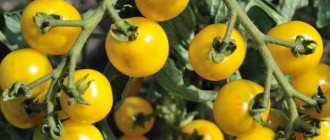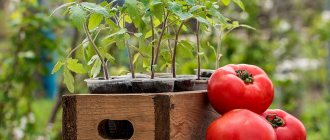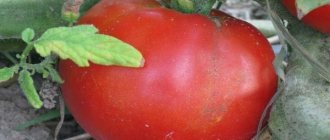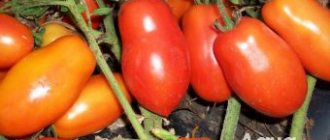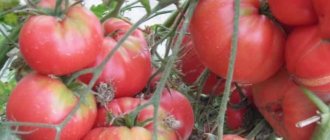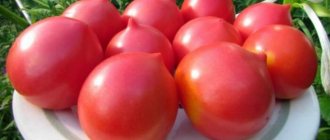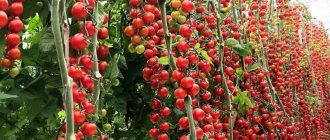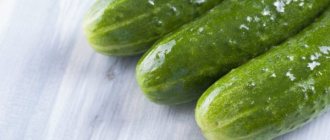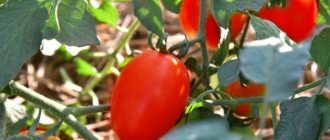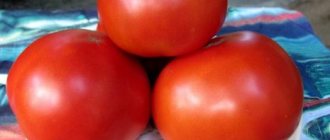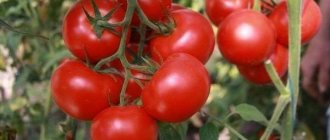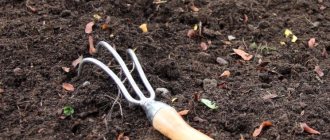What are semi-determinate tomatoes?
Tomatoes are deservedly a popular vegetable in our gardens. Recently, semi-determinate tomatoes have attracted more attention from gardeners. Here, the basis for the characteristics is such a criterion as the height of the bush. There are also determinate (short-growing) and indeterminate (tall) tomatoes.
Tomatoes of the semi-determinate type occupy a middle position, taking the best qualities from determinate and indeterminate varieties. For example, the harvest can be obtained earlier than from indeterminate ones, by 10 - 12 days. And this is perhaps the key factor. Plants are resistant to temperature changes and diseases. Tomatoes love warmth, and most regions of our homeland cannot boast of a long sunny summer. That's why tomatoes are grown in greenhouses. And you have to take into account the space.
Determinate and indeterminate tomatoes: what is the difference
You can see the difference between a determinate and an indeterminate plant at any stage of the growing season:
- During flowering, the first cluster appears after 3 pairs of leaves in determinate tomatoes. Indeterminate ones form an inflorescence only after 8 or 9 shoots.
- Seedlings can be distinguished by the size of the cotyledon, which is up to 3 cm in low-growing varieties, and 3-5 cm in tall varieties.
- Differences in the number of fruit shoots: tomatoes with limited growth produce brushes every 2 leaves, indeterminate ones - every 3.
- A determinate bush ends in an inflorescence.
Temperature
Control the temperature in the greenhouse. Still, this is the main criterion for obtaining a good harvest result. When planting seedlings, the soil temperature should be at least +15 degrees. For tomatoes, the optimal temperature is +22+25 degrees during the day, at night not lower than +15 degrees. Too high and too low temperatures have a bad effect on the plant. It stops growing and does not set fruit. In semi-determinate tomatoes, this can cause topping and the plant stops growing upward.
Types and their differences
Determinate, semi-determinant and super-determinant varieties of tomatoes: what are they and what are their features?
- Determinant . Flower clusters, after 5-6 leaves appear, are formed every three leaves; such varieties are usually early or mid-early ripening.
- Semi-determinant . After the formation of 10-12 flower clusters, which are laid every two true leaves, the plant stops growing, the very first brush will be laid after 8 leaves. They are well suited for growing in greenhouses, have a fairly tall growth, and have an average ripening period.
- Superderminant . Flower clusters are laid after 1-2 leaves, and after 5 of them are formed, a shoot begins to appear, which will stop the growth of the entire plant; these varieties are early ripening.
Watering
Tomatoes are plants that love moisture. But they can do without watering for a short time.
Seedlings, after planting in a greenhouse, should be watered frequently, but not flooded. The guideline is the drying of the top layer of soil. An adult plant, before the tomatoes ripen, can be watered 2 times a week, but very generously. It is required that the soil is saturated with water to a depth of 15–20 cm. And during the ripening period of tomatoes, frequent watering is required. However, keep in mind that excess moisture can lead to the development of fungal infections. Remember that tomatoes do not like water getting on their leaves and stems. Therefore, water exclusively at the root, do not use a watering can or sprinkler when watering. By watering at the root, another goal is achieved. The humidity in the greenhouse does not increase, which should be at the level of 50 - 60%.
General information
There are significant differences in the degree of growth and development of tomatoes . They can be divided into two types:
- interdeterminant;
- determinant.
Important : Varieties that belong to the first type are not limited to a flower cluster at the central top, so their growth does not stop. Such tomatoes are usually grown in greenhouses; they reach a height of two meters, and sometimes more, depending on conditions, soil, and care.
Determinate varieties always stop growing after the formation of an ovary with fruits at the end of the shoot . The growth of tomatoes of this type continues from the stepson, which is located in the axil of the leaf under the upper raceme. The first flower cluster in such varieties appears after 6-7 true leaves and below, so it is easy to distinguish them from interdeterminate varieties even at the seedling level. In an adult plant, brushes appear in less than 3 leaves.
These varieties ripen quickly, do not require repeated staking, are suitable for growing in open ground, and do not require constant pinching. Recommended for cultivation in various climatic zones, including the northern regions.
Standard varieties are also classified as determinant varieties. Such tomatoes are distinguished by a very compact bush, which has a strong trunk and practically does not need tying or support. They do not require pinching and do not create thickening on the site, but due to the fact that they take up little space, they allow you to get a larger harvest due to the frequency of planting.
They are grown everywhere on an industrial scale in fields, because... resistant to drought, temperature changes, and cold. The fruits of standard tomatoes are well stored, do not lose their presentation during transportation , are formed on the bush in large quantities, and ripen together. The root system is located close to the surface, which allows the plant to better absorb nutrients and moisture.
Stepsoning
Bush formation
It is best to form a plant into 2 stems. The strongest and most viable stepson is formed under the first cluster; it will bear good fruit. Form the second stem from it. Form 2 – 3 brushes on the side shoot, 3 – 4 brushes on the main stem.
Shape the harvest with additional means. Thin out the first two clusters, leaving 3 - 4 tomatoes. Form other brushes into 6–8 tomatoes, remove the gnarled ovary.
To prevent the topping process from threatening the yield, always leave reserve shoots on the plant. Remove if new stepsons appear.
Removing stepchildren
Stepchildren are side shoots. Stepping is their removal. This is done to speed up the ripening of tomatoes and increase their size. For gardeners, it is akin to some kind of ritual. This must be done, otherwise you will end up with a huge amount of foliage and a small amount of tomatoes. In addition, pinching improves the lighting of plants and contributes to an earlier harvest. Remove the stepchildren when they have reached a length of 5–6 cm at least once every 10 days. It is best to apply the stepsons in the morning; the stepsons are easier to break off, and the wound heals immediately. If pinching is carried out less frequently, then it is much more difficult to determine what needs to be torn off. And tearing off a large stepson can harm the stem.
Removing leaves
In addition to pinching, the leaves themselves are also removed. It happens that gardeners remove all the leaves, supposedly in order to speed up the ripening of tomatoes. The opinion is incorrect. The plant will begin to restore green mass, the fruits will become unimportant at all. Trim the leaves, but without fanaticism. Leaves that are in contact with the ground must be removed. This is done to prevent late blight infection. If the plants are touching their leaves, they can be partially trimmed. And then the tomatoes will receive both sunlight and carbon dioxide in abundance.
Top dressing
It is possible to obtain an early harvest from semi-determinate tomatoes; this requires timely feeding of the plants. A flowering plant needs mineral fertilizers, which focus on phosphorus content. The process of ripening tomatoes will require the addition of potassium. The appearance of the plant will tell you which microelements it lacks. Slow plant growth and pale leaves indicate that the plant lacks nitrogen. Excess nitrogen leads to the formation of rich greenery, the plant “fattens”, there may be no flowers and tomatoes. A violet tint of greenery indicates a lack of phosphorus, and its excess leads to yellowing of the foliage and its fall, the ovary also falls off. The plant may die if there is not enough potassium, and its excess leads to the appearance of dull spots on the leaves.
If it is not possible to apply organic fertilizers, and these include peat, manure, chicken droppings, then feel free to apply mineral fertilizers. Read the instructions and feed the plants. It is better to use complex mineral fertilizers that contain several elements necessary for plants.
Tomato varieties
"Magnus F1"
Medium early, fruits appear 95 -105 days after germination. The tomatoes are flat-round in shape, unripe are light green in color, and ripe ones are bright red, weighing 130 - 160 g. They tolerate transportation well. Good taste. Suitable for canning and fresh salads. The plant resists diseases and temperature changes well.
"Khlynovsky F1"
Tomatoes of this variety ripen 105–110 days after germination. The fruits are large, fleshy, weight reaches 220 g. Ripe tomatoes are red in color.
The plant is resistant to diseases and temperature changes. Suitable even for beginners.
"Baron F1"
An early ripening variety, the fruits ripen 108–115 days after emergence. Ripe tomatoes are red in color and flat-round in shape. 122 – 134 g fruit weight, good taste. Resistant to diseases, tolerates temperature fluctuations well.
Also suitable for those who are taking their first steps in growing tomatoes. It won't cause much trouble.
"Merchant F1"
High-yielding hybrid, fleshy, large tomatoes, fruit weight 130 – 160 g.
They are stored for a long time and do not become flabby at room temperature for up to three months. Small tomatoes can be stored for up to 6 months.
"Gunin F1"
Early ripening variety, fruit ripening 100–110 days from germination. Tomatoes of good taste, weighing up to 120 g.
The plant tolerates unfavorable natural conditions well, which makes it possible to produce fruits for a long time.
"Gravity F1"
Early ripening, high-yielding variety. Tomatoes are slightly flattened, bright red in color. They have a rich aroma and excellent taste. Large tomatoes, 200 – 220 g. The variety is resistant to diseases.
"Silhouette F1"
An early ripe hybrid, easy to grow, the fruits are dense, brightly colored, weight up to 160g, and tolerate transportation well.
"Ivet F1"
Very early hybrid, disease resistant. The tomatoes are round in shape, weighing 140–150 g, resistant to transportation, and can be stored well for up to 30 days.
Red Arrow F1
A reliable hybrid, low-leaved, shade-tolerant plant. You can plant plants densely to save space. The weight of tomatoes is 90 - 120 g. The plant tolerates temperature changes well and is resistant to diseases. Tomatoes are early ripening and tolerate transportation well.
Eagle beak
Tomatoes have an unusual beak shape, weighing up to 800g. The tomatoes are meaty, juicy, have a rich taste, and store well.
An overview of one of the varieties is presented in the following video:
